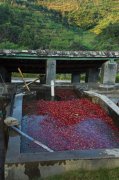The tasting term coffee taste of coffee

Before you begin to understand the characteristics of coffee beans from different regions, you must know the following taste words in order to know the characteristics and flavors of coffee beans in each country.
Body
The correct taste should be to feel the thick, thick texture of coffee after entering the mouth.
The tactile impression of the tongue in terms of weight, quality, and consistency ranges from light, watery thinness to medium, thick consistency to deep, syrupy, super-thick fat.
Acidity
A taste on the back of the tongue, not quite the same as the acid lemon makes you salivate. This acidity describes a fresh, bright, and refreshing feeling.
The characteristics of Arabica coffee beans, which are usually produced at high altitudes and high density, are not present in Robusta coffee beans at low altitudes.
Bitter (bitter)
Bitterness is one of the four main tastes of coffee, usually for the following five reasons:
Variety: Robusta is usually more bitter than Arabica.
Producing area: coffee usually produced in sumatra, java, indonesia bitter strong.
Roast: Deep roasts are more bitter than light roasts because they are more caramelized and carbonized.
Caffeine: Robusta is more bitter than Arabica because it contains twice as much caffeine.
Extraction time: The longer the extraction time, the more bitter it is.
Sweet (sweet)
Coffee is described as even and delicious, flawless, perfect coordination, aftertaste endless taste, this sweet and sweet taste is also the flavor that high-quality coffee can emit.
Aroma (aroma)
The smell of coffee after brewing, including caramel, fruit, flower, rich, spicy and so on.
Flavor
It is the overall impression of aroma, acidity and alcohol.
Strong (strong)
Usually it refers to the intense flavor of coffee beans under dark roasting, which cannot be equated with high caffeine content.
In fact, the highest caffeine content is light canned coffee, because most of them contain a lot of high caffeine Robusta.
Tangy
It's an aggressive sour smell, almost fruity and alcoholic in nature.
Costa Rican premium coffee grown in the highlands usually has a spicy flavor.
Briny (salty)
This is usually due to excessive heating or because the beans themselves are too rich (coffee beans themselves contain 5% minerals).
Winy
It resembles an overall feeling with a slight bouquet, a fruity acidity and a smooth alcohol.
Important Notice :
前街咖啡 FrontStreet Coffee has moved to new addredd:
FrontStreet Coffee Address: 315,Donghua East Road,GuangZhou
Tel:020 38364473
- Prev

The practical version of Golden Coffee Theory: 2012 to Golden Section ratio
To drink 300ml coffee, how many grams of coffee beans should be used? gold cup gold coffee theory easy to remember practical version! Simple version (coffee cup capacity * 1.2%) / 20% = required coffee beans very simple version coffee cup capacity * 0.06 = need to put coffee beans beautiful version coffee cup capacity * 6.18% = need to put coffee beans to drink 300ml coffee, how many grams of coffee beans should be used? 300 "0.0618" 18.54
- Next

Wet treatment methods and steps of Yunnan coffee beans
As the harvest season is almost over, I would like to add an overview of the coffee processing process. In this blog post, I will introduce to you the steps of wet treatment in Yunnan after coffee picking. After harvest, the berries are either sent directly to the pulp collector (if the harvest is done well), or concentrated in a siphon tank filled with water. The berries are here.
Related
- Guji coffee producing area of Guji, Ethiopia: Humbela, Shakiso, Wulaga
- What is the most expensive variety of Qiloso in BOP multi-variety group?
- How to store the coffee beans bought home?
- Why are Yemeni coffee beans so rare now?
- Ethiopian Sidamo all Red Fruit Sun Sun Santa Vini Coffee beans
- SOE is mostly sour? What does it mean? Is it a single bean? what's the difference between it and Italian blending?
- Is Italian coffee beans suitable for making hand-brewed coffee?
- How to choose coffee beans when making cold coffee? What kind of coffee beans are suitable for making cold coffee?
- Just entered the pit to make coffee, what kind of coffee beans should be chosen?
- Can only Japan buy real Blue Mountain Coffee? What are authentic Jamaican Blue Mountain coffee beans?

